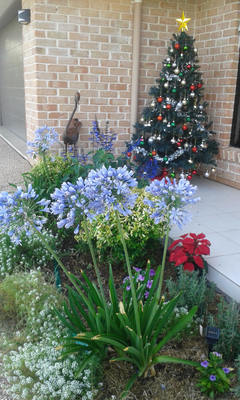CHRISTMAS is blooming and Free Times gardening columnist BEATRICE HAWKINS has captured the colours of the season…
CHRISTMAS is coming … three more sleeps after you have read this. I trust that you all enjoy a safe, happy and blessed Christmas holiday period.
If you have any last-minute presents to be wrapped be sure to remember the “Blue Care” wrapping service located this year a little out of the way at the bottom of the escalators in the Rose City Centre.
This is their major fund-raiser for the year and we all appreciate the wonderful service they provide.
Another beautiful flower at this time of year is the “Star of Bethlehem” agapanthus lily, a real star of the season growing almost anywhere except where the weather is extremely hot or cold. Surviving on very little water when established they are a truly versatile plant and look wonderful in massed plantings. They are used to good effect in roundabouts in many areas and always look great planted down country driveways.
In some areas they are classed as an environmental weed as they spread by seed and grow so easily while in other areas they are used as a fire retardant plant because of their fleshy green leaves and also for holding banks and stopping erosion with their large and tangled root system.
Most of the environmental problems with feral plants have developed from illegal and careless dumping by irresponsible people. If you have any garden debris to be disposed of, please be sure to take it to the local tip and don’t just leave it in the bush or by the roadside.
Many of the new varieties, such as the deep purple “Black Pantha”, have sterile seed and can only be propagated by division so cause no weed problems.
They are available in a large range of sizes from dainty little miniatures suitable for garden edges to two-metre high giants to put at the back of borders and in a range of colours from the usual bright blue to white, bi-colours and now in deep purple/black and mauve pinks.
While they seem to thrive on neglect, a feed of organic fertiliser in early spring will help the developing flowers and dividing the clumps every four or five years will keep the plants healthy and producing a wonderful display.
I have some of the common blue and white plants growing but aspire to obtain some “Black Pantha” for inclusion in my garden next year.
These great plants are native to South Africa but have been successfully introduced to many countries and absolutely thrive in Australia.
Some more garden trivia for this week’s column.
* There are over 20,000 species of edible plants in the world but 90 per cent of human food is supplied by only 20 species.
* Peaches, pears, apricots, quinces, strawberries and apples are all members of the rose family.
* From a botanical standpoint pumpkins and tomatoes, cucumbers and zuchinni are fruits not vegetables while rhubarb is a vegetable.
* Tomatoes are the world’s most popular fruit with over 60,000,000 tonnes grown each year. There are at least 10,000 varieties of tomatoes.
* Bananas are the second most popular fruit in the world.
* Pineapples are the only edible member of the Bromeliad family and are actually a berry.
* A herb is made from the leaf of a plant while a spice is from the seed, bark, root, berry or bulb.
* Vanilla “beans” are actually the pod of an orchid, Vanilla planifollia, and are more closely related to corn than to green beans.
Don’t neglect to water your plants over the holiday period. A good thorough deep soaking will allow you a respite for a few days and a good layer of mulch is also a good investment.







